Featured Connected CMMS
What Happens When Revenue Ops and Service Teams Align in FM
Author: Yogendrababu Venkatapathy, Co-founder, Facilio
Facilities management is fast evolving—But are your teams in sync?
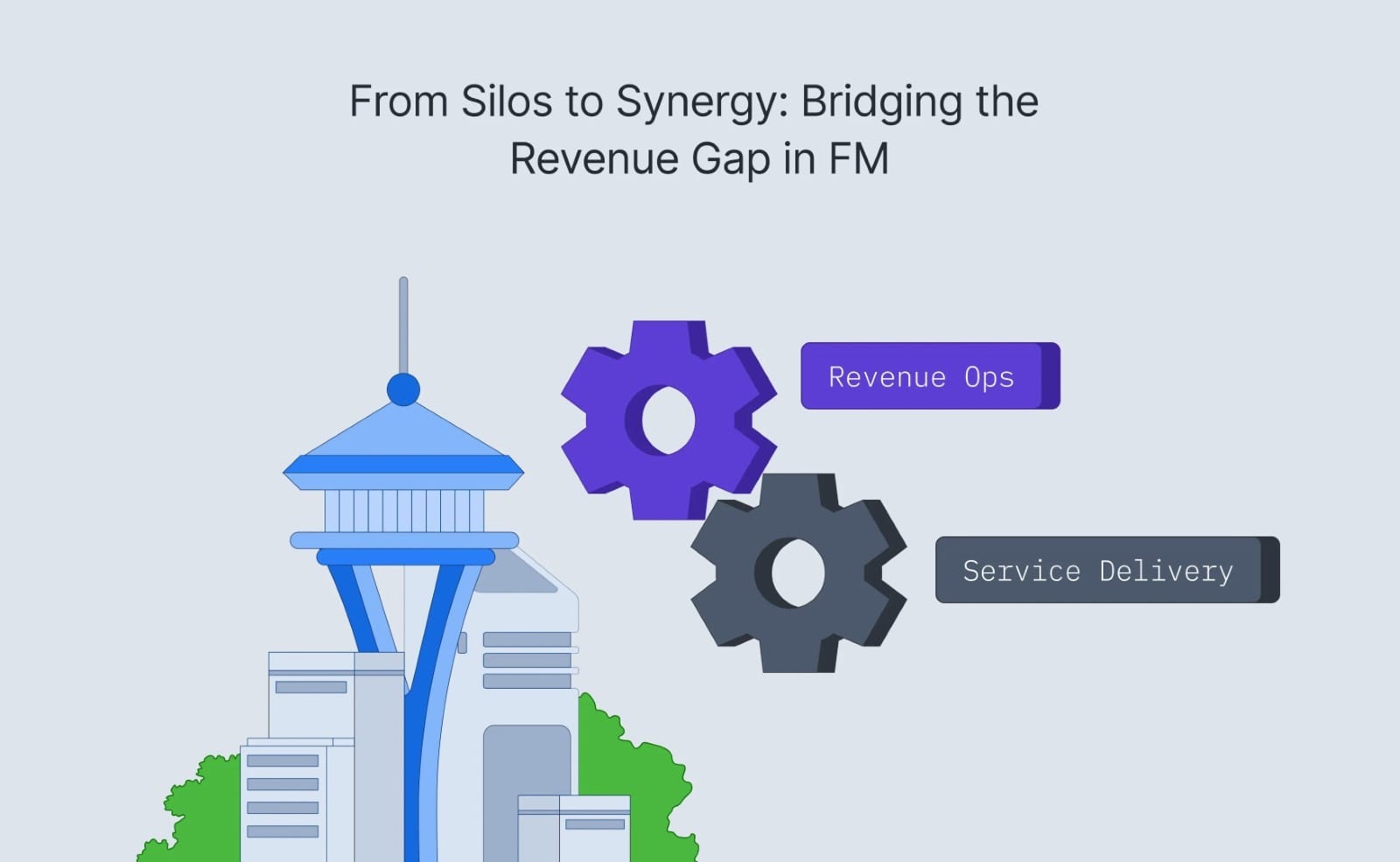
Once seen as purely operational, facilities management is now recognized as a strategic lever for driving efficiency, value, and growth.
With the global FM market projected to hit $2.28 trillion by 2032, the pressure is on to not just win new contracts but also deliver consistently great service.
Yet, many FM companies still run with Revenue Operations and Service Delivery teams working in silos. And that’s where things break down:
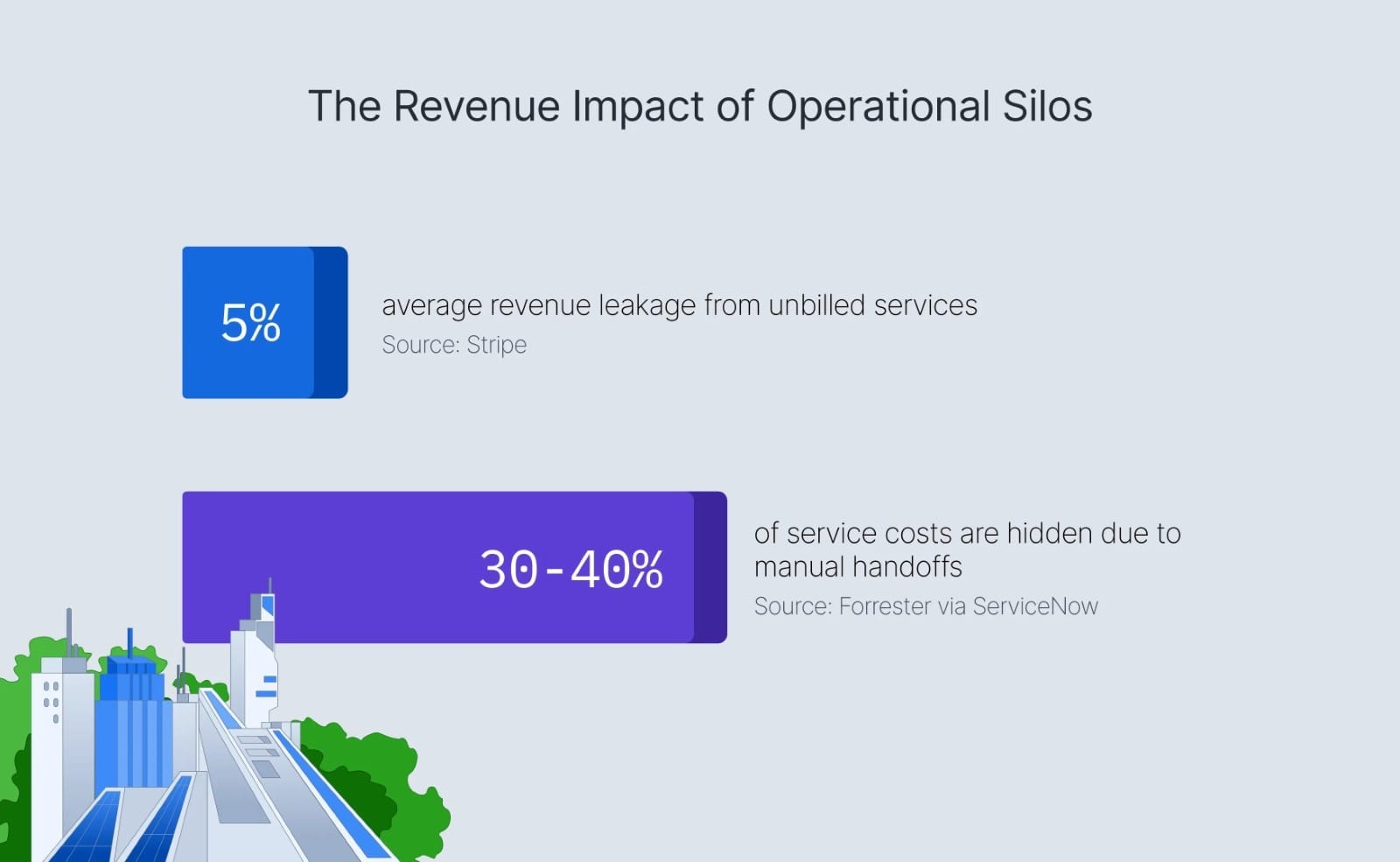
- Revenue Loss: Up to 5% of earnings can slip through the cracks due to missed billing or underpricing.
- Inconsistent Service: Disconnected teams often lead to gaps in delivery and unhappy clients.
- Operational Delays: Poor coordination slows down mobilization and puts SLAs at risk.
So What’s the Fix?
After years of trying to bridge this gap through manual processes, spreadsheets, or siloed point solutions, many FM leaders have come to the same realization: alignment won’t happen by accident—it must be designed into how teams work.
And that begins with shared systems, shared data, and shared accountability.
Which brings us to the critical enabler: a modern Computerized Maintenance Management System.

Here’s what a Connected CMMS brings to the table:
a) One source of truth
Everyone from sales to field teams works from the same real-time view: SLA commitments, scope of work, billing terms, and service history. This clarity prevents over delivery, validates billing, and ensures teams stay aligned on what’s been promised—and what’s been performed.
b) Better teamwork, less finger-pointing
When teams share KPIs and work within the same system, accountability becomes built-in—not personal. Automated workflows reduce back-and-forth, while shared metrics ensure everyone’s driving toward the same outcomes, not passing blame when things go off track.
c) Make well-informed decisions
Real-time insights into SLA performance, technician productivity, and cost-to-serve metrics help teams spot patterns early—like over-servicing low-margin contracts or repeat failures on specific assets.
Up next, we’ll break down what really goes wrong when teams don’t talk, how getting everyone on the same page changes the game, and how a solid CMMS can help you make more money and keep clients happy—without the chaos.
But to understand how all the pieces fit together, we first need to unpack a key player in this equation: Revenue Operations.
What Does Revenue Operations Really Do in Facilities Management?
As Facilities Management (FMd continues to evolve from a back-office function to a strategic business driver, Revenue Operations (RevOps) has taken center stage. It’s no longer just about bringing in revenue—it’s about doing it smarter, faster, and more sustainably.
RevOps acts as the connective tissue between sales, finance, customer success, and service delivery teams. It ensures they’re all working from the same playbook to drive profitable growth.
In short?
RevOps is how FM companies turn strategy into revenue, minus chaos.
Here’s How RevOps Brings the Heat in Facility Management
a) Smart pricing, solid contracts
RevOps keeps tabs on market trends, service costs, and client needs to make sure pricing isn’t leaving money on the table. They adjust rates in real time so you're never undercharging or overpromising.
b) Real forecasts, not guesswork
They build forecasting models that actually reflect what’s happening on the ground—renewals, upsells, slow seasons—so you can plan headcount, budgets, and resources without flying blind.
c) Stop the churn before it starts
By tracking customer satisfaction and usage patterns, RevOps flags problem accounts early. That gives teams a chance to course-correct, whether by adjusting service levels or reworking contract terms.
d) Clean, fast billing
Billing delays and errors?
By linking billing systems to service delivery data—like completed work orders, technician hours, parts used, and SLA fulfillment—every invoice reflects exactly what was delivered, making it accurate, timely, and easier to collect.
e) Know what it really costs to serve
RevOps breaks down how much it costs to serve each client, so you know which accounts are driving profit and which ones need a rethink. That’s how you protect margins without cutting corners.
f) Systems that talk to each other
No more bouncing between platforms. RevOps pulls data together from your CRM, CMMS, billing tools, and reporting systems so everyone can work from the same real-time information.

But systems alone don’t deliver results.
That responsibility lies with the Service Delivery team—the frontline force turning strategy and contracts into tangible outcomes.
What do the best service delivery teams actually do?
If Revenue Operations sets the commercial promise, Service Delivery determines whether that promise gets fulfilled—or falls short.
And that fulfillment isn’t just about completing tasks. It’s about orchestrating resources, execution, and customer perception in real time, across multiple locations, contracts, and SLAs.
The gap between average and excellent FM performance? It lives here.
Here’s how leading Service Delivery teams make that difference:
a) They operationalize agility, not just schedules
Dispatch and scheduling aren’t logistics—they’re business levers. The best teams adapt in real time, factoring in technician availability, asset priority, and client impact—not just who’s free.
b) They treat work orders as intelligence assets
Work order management is no longer transactional. Teams that capture not just the task, but context—response times, parts usage, task outcomes—feed invaluable data back into asset planning, pricing models, and resource forecasting.
c) They balance risk and response with precision
It’s not about doing more preventive or being faster on reactive. It’s knowing where to invest, which type of maintenance to use, and why. That judgment is what protects margin and uptime simultaneously.
d) They drive satisfaction by closing gaps, not surveys
Service quality isn’t measured by NPS alone. The best teams identify recurring service friction (response gaps, communication breakdowns, misaligned expectations) and solve them before they show up in feedback.
e) They don’t “track” SLAs—they negotiate with data
Top-performing service leads don’t just monitor compliance. They use trend data to identify where SLAs are unrealistic, underpriced, or being eroded by client-side delays. This data fuels smarter renegotiations and renewal positioning.

Rethinking service delivery: The frontline of revenue realization
In high-performing FM organizations, Service Delivery isn’t just about closing work orders—it’s the frontline where revenue is either protected or quietly slipping through the cracks.
It’s where:
✅ Margins are safeguarded or eroded based on how efficiently services are delivered
✅ SLA compliance directly affects billing accuracy, penalties, and upsell potential
✅ Daily execution—how technicians show up, how issues are resolved—shapes long-term client trust and retention
But too often, service teams are flying blind, lacking visibility into contract terms, financial implications, or client sentiment. And that disconnect comes at a cost.
What goes wrong when execution is disconnected?
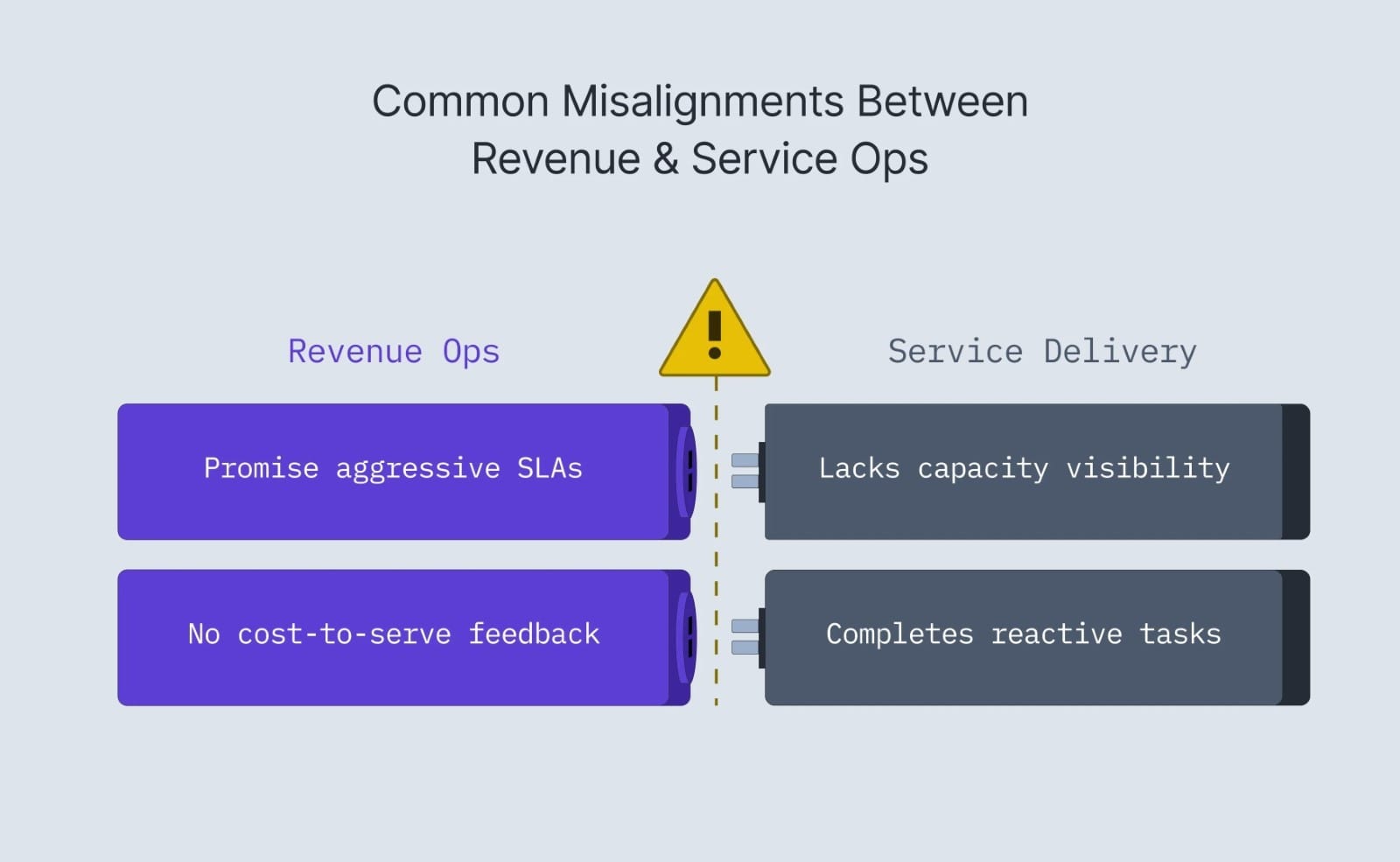
Even the smartest commercial strategy will fail if service execution isn’t tightly aligned.
Here’s what that misalignment actually looks like on the ground:

Bottom line: It’s not just inefficiency—it’s lost revenue in disguise.
What today’s service teams really need to do
Service Delivery teams should no longer be seen as passive executors.
They’re in the best position to protect margins, accelerate value, and shape strategy—if they’re empowered to do so.
1. Flag margin risks from the frontline
Technicians see where scope creep, repeated site visits, or inefficiencies are eating into profit—but this feedback often never makes it back to commercial teams. Give service leads a formal role in pricing and contract review cycles to avoid underquoting and delivery friction later.
2. Accelerate time-to-value in the first 60 days
Quick wins post-mobilization—like meeting first SLAs, delivering asset insights, or catching up on deferred maintenance—create early client confidence. These small victories increase perceived value, drive satisfaction scores, and make future renewals or upsells easier.
3. Close the feedback loop between delivery and revenue strategy
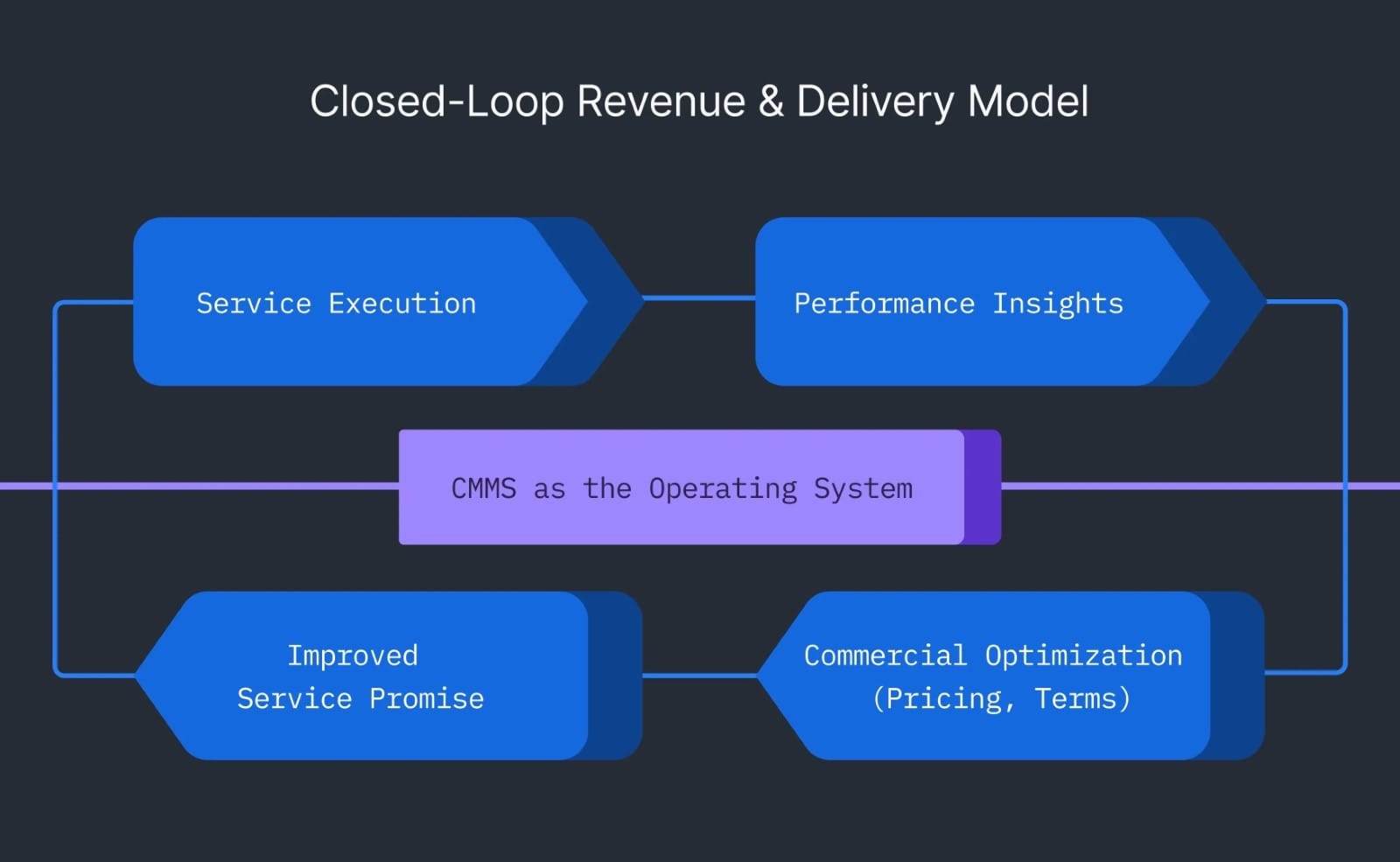
Field teams encounter client realities that sales decks can’t predict: unclear scope expectations, bottlenecks, and service friction. Without a system to capture and route that intel back to Revenue Ops and Account Management, you miss the opportunity to adapt pricing, reset SLAs, or evolve your offering. Delivery teams must not just execute strategy—they should help refine it.
What’s missing...? Shared context
But, make no mistake. More tools aren’t the answer.
What’s needed:
- Unified systems where service, billing, and contracts speak the same language
- Real-time visibility across teams so everyone understands the scope, priorities, and expectations
- Centralized performance metrics that keep everyone aligned on outcomes, not just tasks
If you want to drive profitability, renewals, and long-term client success in FM:
👉 Stop treating Service Delivery as just “ops”
👉 Start empowering it as a revenue driver
Because where work gets done is exactly where business value is delivered.
Connected CMMS: The strategic bridge between revenue & service in FM
In today’s fast-moving FM world, aligning Revenue Operations and Service Delivery is non-negotiable. A Computerized Maintenance Management System (CMMS) is the connector that keeps both sides in sync, turning data into dollars and operations into outcomes.
1) Unified Data = Smarter, Faster Decisions
A Connected CMMS pulls together everything—
✔️ Work orders
✔️ SLA metrics
✔️ Technician productivity
All into one real-time dashboard.
📌 Why it matters: Now both RevOps and Service teams are looking at the same numbers, making decisions based on facts, not guesswork.
2) A Billing That’s Bulletproof
Tired of revenue slipping through the cracks?
A Connected CMMS ensures that every billable element is captured—not just what’s planned, but what’s actually delivered.
It tracks:
- Labor hours logged per job, per technician
- Parts and materials used in the field
- Extra services that weren’t part of the original contract—like emergency callouts, client-requested add-ons, or tasks performed beyond the agreed scope
📌 This is where scope creep shows up: when teams perform additional work—intentionally or not—without formal change orders or billing. Left unchecked, it erodes margins.
A CMMS flags these variances in real time, so service leads and finance teams can take corrective action, adjust contracts, or invoice accurately.
The result: No more missed charges, faster collections, and cleaner cash flow with fewer disputes.
3) SLA monitoring in real time
Missing SLAs cost you trust and renewals.
A CMMS lets you:
- Track SLA compliance live
- Flag issues before they escalate
- Show clients you're on it before they ask
📌 Outcome: Fewer breaches, stronger retention, and easier renewals.
4) Real collaboration, not just lip service
A Connected CMMS acts as a shared source of truth, breaking down silos:
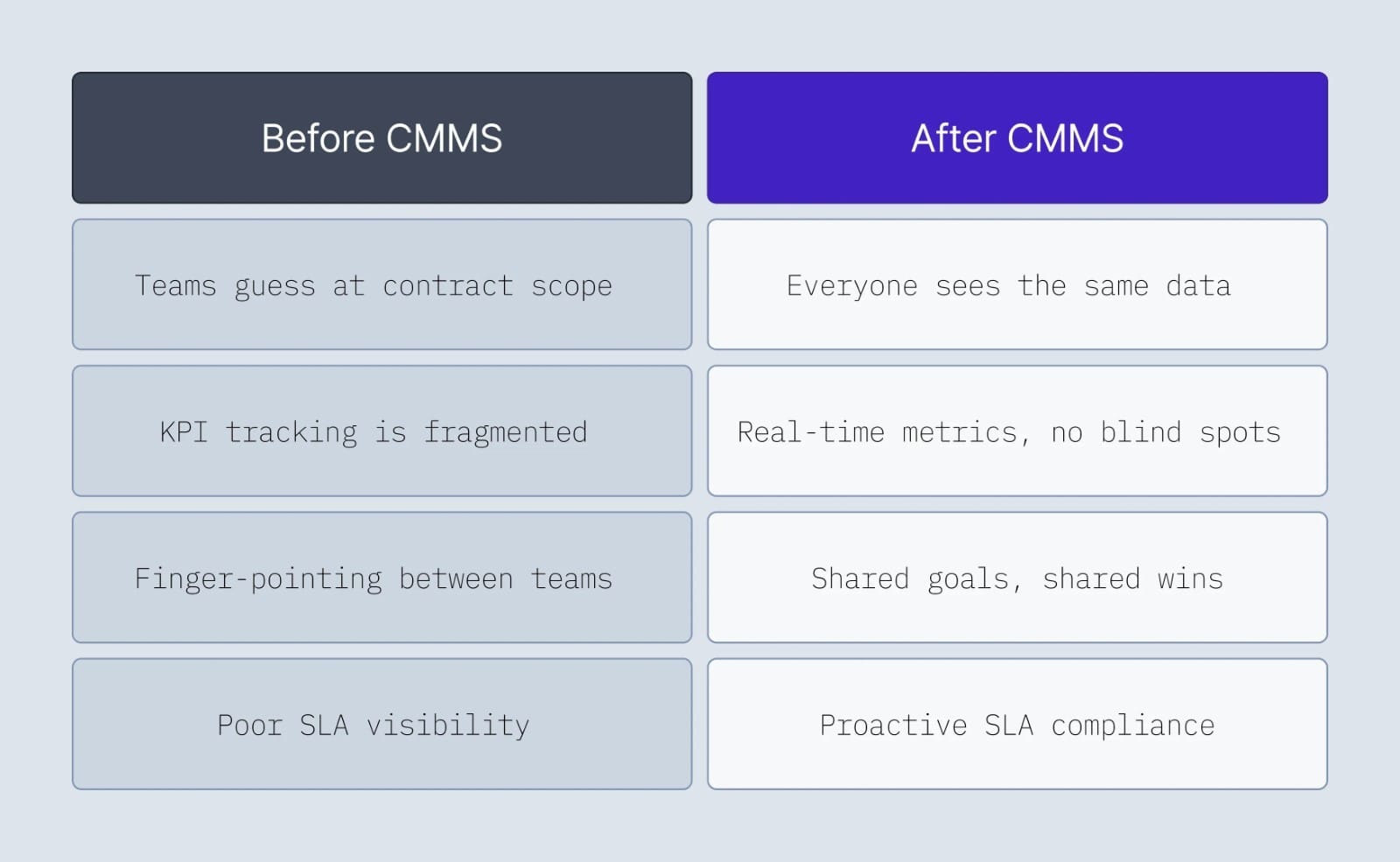
Make RevOps + Service Delivery your new "Power Duo"
In today’s Facilities Management landscape, operational excellence is expected—it’s no longer enough to stand out. The real differentiator is aligning service delivery with revenue strategy.

When these teams work in isolation, organizations face lost margins, slow decisions, and weakened client trust. But when they operate in sync—sharing data, KPIs, and accountability—they create scalable, sustainable growth.
This shift doesn’t require more tools. It requires a smarter operating model.
A Connected CMMS becomes the foundation, linking contracts, costs, and compliance into one source of truth.
FM leaders who get this right don’t just deliver services.
They drive revenue on purpose, not by accident.
